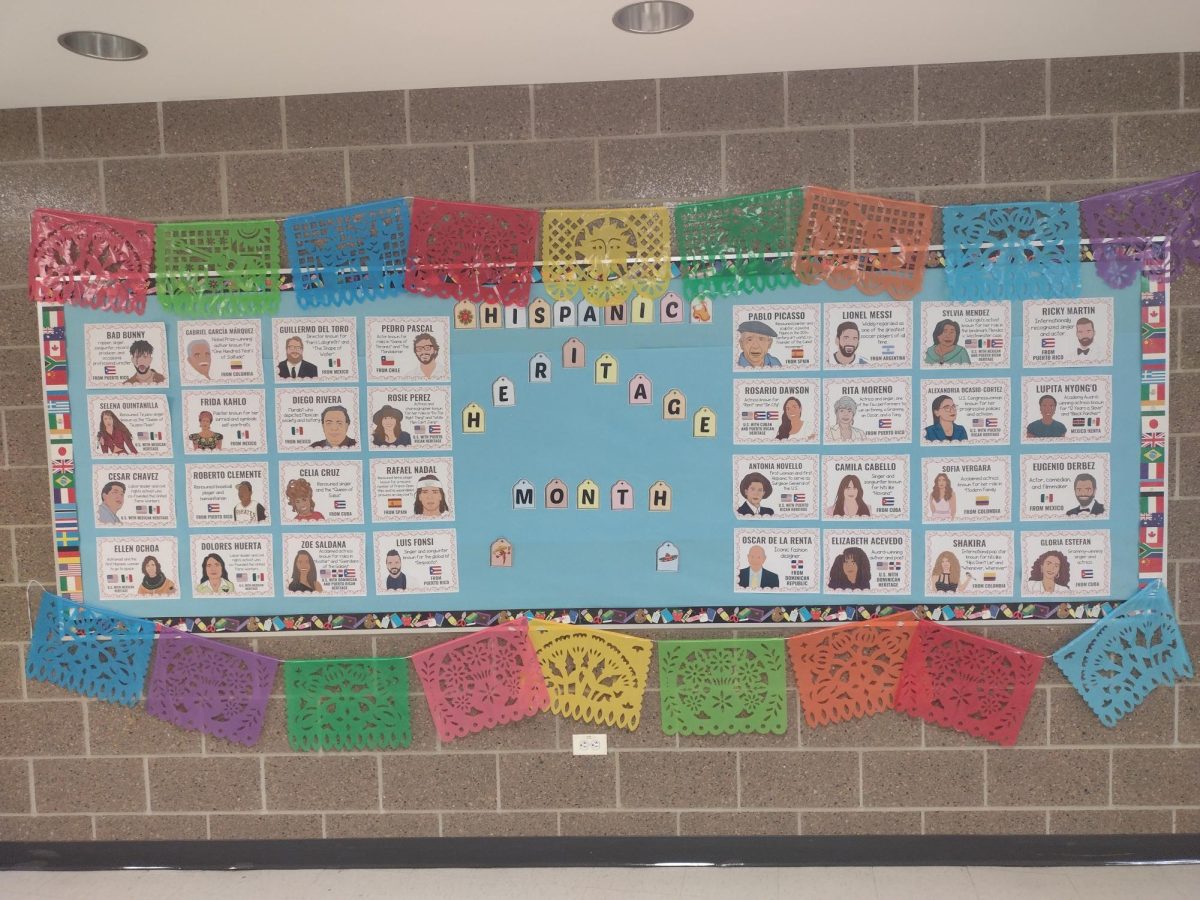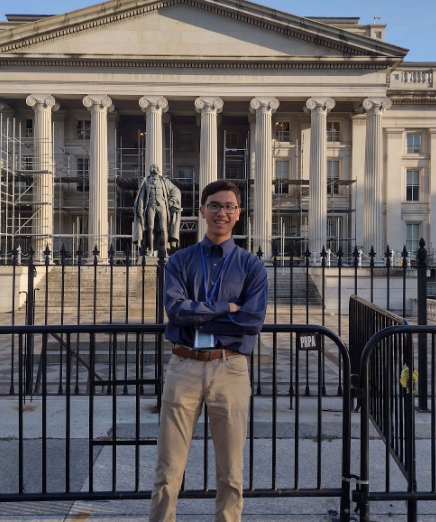From Sept. 15 to Oct. 15, the United States celebrates Hispanic Heritage Month across the nation. It is meant to highlight the great figures and achievements of the Hispanic community in the U.S., in a similar fashion to other month-long observances.
Hispanic Heritage Month originated as Hispanic Heritage Week in 1968 and was extended in 1988. Typically, Latin American culture is represented, although the terms “Hispanic” and “Latino” are often confused or used interchangeably. While there is overlap, they are not synonyms. Hispanic refers to someone from (or with heritage from) a Spanish-speaking country. Latino may apply to anyone from (or with heritage from) a country in the Americas that speaks a Latin-derived language, such as Spanish or Portuguese. Overall, the month honors Hispanic and Latino culture and history in a tradition that is unique to the U.S.
“It’s a time to remember all the positive impacts we’ve had on our society,” said Multilingual and Foreign Language department teacher Richard Burrell said. “We oftentimes forget the really outstanding struggles and ways that people have overcome their issues.”
There are 21 Hispanic countries in the world, including the U.S. territory of Puerto Rico. The Spanish language is the one factor that ties these nations together, which range from Equatorial Guinea to Argentina. Latin America’s status is more disputed. There is a gray zone for some countries and territories, such as Belize, where English is the official language but Spanish is also widely spoken. The number of countries and territories considered to be Latin American ranges from 21 to 34. Regardless, Latin America is an incredibly diverse region that is hard to define, full of vastly different nations and cultures. Furthermore, it’s also crucial to note that Hispanic is an ethnicity, not a race. A person of any race could be Hispanic, which is in itself a broad term.
The month is split between Sept. 15 and Oct. 15 because eight Hispanic countries celebrate their independence days in that timespan. Additionally, Indigenous People’s Day/Columbus Day is recognized on October 9, although that brings up a discussion subject to controversy. Nevertheless, the month features a wide array of displays, observances and celebrations. Parades, festivals and other community events featuring art, food and advocacy work take place all over the U.S.
“I think it’s a time… where all people can be inspired by the stories that they’re hearing,” Burrell said. “I think it is a time to remember what Latino and Hispanic heroes have contributed to our society. It’s a very intentional period of reflection.”
Over 60 million Hispanics live in the U.S., accounting for approximately 19 percent of the total population. Many subcultures within the U.S. have formed, such as Chicano culture. Amongst this diversity, there are also different views on Hispanic Heritage Month. These kinds of month-long observances don’t exist in Latin American countries and the idea of Latino or Hispanic culture as a whole isn’t as prominent. Usually, people will identify more with their nationality than with terms that define broad regions. Hence, the tradition can be seen as somewhat strange or distant for some Hispanic and Latino Americans, especially if they have their own national celebrations that lie elsewhere in the year. Nevertheless, there are plenty of Hispanic and Latino Americans who celebrate the month and take it as an opportunity to speak out for social and humanitarian causes.
“For some people, it’s nothing,” Burrell said. “For other people, it’s a lot.”
The U.S. is a diverse country where the achievements of different groups have contributed to progress and development. Hispanic Heritage Month sheds light on the contributions from the Hispanic and Latino communities to the country.
“We have these things because we are diverse, so it’s a way to celebrate that diversity instead of enforcing homogeneity,” Burrell said. “I think, when appropriately and properly celebrated, it can speak to all people. It is uniquely American, but that is because we are so diverse, and I think that makes us stronger.”
Versión en español
Mes de la Herencia Hispana
Desde el 15 de setiembre hasta el 15 de octubre, Estados Unidos celebra el Mes de la Herencia Hispana a lo largo de la nación. Su propósito es resaltar las grandes figuras y logros de la comunidad hispana en EE. UU., de manera similar a otras observancias que duran un mes.
El Mes de la Herencia Hispana se originó como la Semana de la Herencia Hispana en 1968 y se extendió en 1988. Típicamente, se representa la cultura latinoamericana, aunque los términos «hispano» y «latino» se confunden bastante o se usan indistintamente. Mientras que a veces coinciden, no son sinónimos. Hispano podría referirse a alguien de (o con herencia de) un país hispanohablante. Latino podría aplicarse a alguien de (o con herencia de) un país en América que habla un idioma romance, como el español o el portugés. En total, el mes honra a la cultura e historia hispana y latina en una tradición única a EE. UU.
“Es un tiempo para recordar todos los impactos positivos que hemos tenido en nuestra sociedad”, dijo el profesor del área multilingüe y de idiomas extranjeros Richard Burrell. “A menudo nos olvidamos de los desafíos sobresalientes y las maneras en que las personas han sobrepasado sus problemas”.
Hay 21 países hispanos en el mundo, incluyendo el territorio estadounidense de Puerto Rico. La lengua española es el único factor que une a estas naciones, que varían de Guinea Ecuatorial a Argentina. El estatus de Latinoamérica está más en disputa. Hay una zona gris para algunos países y territorios, como Belice, donde el inglés es el idioma oficial pero el español también se habla extensamente. La cantidad de países y territorios considerados como Latinoamericanos varía de 21 a 34. No obstante, América Latina es una región increíblemente diversa que es difícil definir, llena de naciones y culturas vastamente diferentes. Además, es crucial notar que hispano es una etnicidad, no una raza. Una persona de cualquier raza puede ser hispana, lo cual es un término general en sí.
El mes está separado entre el 15 de setiembre y el 15 de octubre debido a que ocho países hispanos celebran sus días de independencia en ese periodo de tiempo. Adicionalmente, el Día de los Pueblos Indígenas/Colón se reconoce el 9 de octubre, aunque eso provoca una discusión respecto al tema que conlleva polémica. Sin embargo, el mes incluye una gran variedad de muestras, observancias y celebraciones. Desfiles, festivales y otros eventos comunitarios incorporando arte, comida y trabajo humanitario toman lugar en todas partes de EE. UU.
“Creo que es un tiempo… en el cual todas las personas pueden ser inspiradas por las historias que están escuchando”, dijo Burrell. “Creo que es un tiempo para recordar lo que los héroes latinos e hispanos han contribuido a nuestra sociedad. Es un periodo de reflexión muy intencional”.
Más de 60 millones de hispanos viven en EE. UU., contabilizando casi el 19 por ciento de la población total. Varias subculturas dentro de EE. UU. se han formado, como la cultura chicana. En medio de esta diversidad, también hay distintas opiniones respecto al Mes de la Herencia Hispana. Estos tipos de observancias que duran un mes no existen en países latinoamericanos y la idea de una cultura latina o hispana entera no es tan prominente. Usualmente, la gente se identifica más con su nacionalidad que con términos generales que definen regiones vastas. Por lo tanto, la tradición puede parecer algo extraña o distante para algunos hispanos y latinos en EE. UU., especialmente si tienen sus propias celebraciones que toman lugar en otras partes del año. Aún así, hay varios hispanos y latinos en EE. UU. quienes celebran el mes y lo toman como una oportunidad para llamar la atención a causas sociales y humanitarias.
“Para algunas personas, no es nada”, dijo Burrell. “Para otras personas, es mucho”.
EE. UU. es un país diverso donde los logros de diferentes grupos han contribuido al progreso y desarrollo. El Mes de la Herencia Hispana distingue a las contribuciones de las comunidades hispanas y latinas al país.
“Tenemos estas cosas porque somos diversos, entonces es una manera de celebrar esa diversidad en vez de obligar la homogeneidad”, dijo Burrell. “Yo creo, cuando se celebra apropiadamente y debidamente, se puede aplicar a todas las personas. Es únicamente estadounidense, pero eso es porque somos tan diversos, y me parece que eso nos hace más fuertes”.
Citas traducidas del inglés






